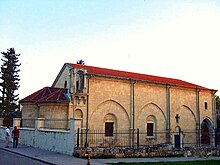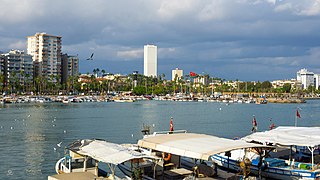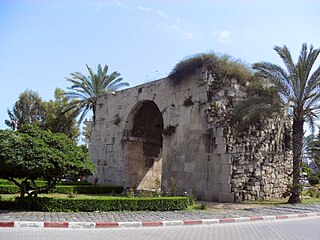Saint Paul's Church is a former church in Tarsus, Mersin Province, Turkey.
Contents

Saint Paul's Church is a former church in Tarsus, Mersin Province, Turkey.


Tarsus, in the Cilicia of the antiquity, in what is now southern Turkey, was an important city during both ancient and medieval ages. The tombs of Daniel of the Bible, and the caliph Al-Ma'mun (786–833), are both in Tarsus. Saint Paul was a resident of Tarsus. He was born and lived in Tarsus as a Jew named Saul and, after converting, made a number of missionary journeys ending in his arrest and beheading by the Roman Emperor Nero in AD 64 or 67 on the 29th of June.[ citation needed ] After Paul's death, Tarsus continued as an important city of the area. It became part of the Byzantine Empire, the Abbasid Empire, the Seljuk Empire, the Armenian Kingdom of Cilicia, the Ramadanids and the Ottoman Empire.
It is not known if there were any churches established by Paul in Tarsus, but in 1704, P. Lucas wrote that there was a Romanesque church which had been built by Paul. V. Langlois visited Tarsus in 1851 and confirmed this. In his words, thick walls that resembled the Roman style, windows that are narrower outside than inside, and thick columns are noticeable, but no other records exist to substantiate this claim.
Medieval Mersin's most important Christian sanctuary was the Armenian cathedral of Hagia Sophia in which Leon I of the House of Rubenid was crowned by Konrad Von Wittelsbach, the Archbishop of Mainz and the representative of Pope, as the king of the Cilician Kingdom of Armenia in 1198.
The Holy Roman Emperor, Frederick I, drowned in Saleph (now called Göksu) river on 10 June 1190, his heart and inner organs might be buried in the Saint Paul's Church. [1]
According to tradition the building date of the Saint Paul Church is 1102, but the present structure, a domeless basilica, was built (or rebuilt) much later, in 1862. [2] The entrance to its grounds is via an ornate gateway. The total area of the church building is 460 m2. The longer dimension of the building consists of face stone walls and blind vaults. The interior measures 19.30 m × 17.50 m (63.3 ft × 57.4 ft). In the northeast corner stands an elevated belfry. The sides of the central nave window had been decorated by angels and landscape depictions. On the ceiling there are frescos of Jesus in the middle, and Matthew, Mark, Luke and John at the two sides. [3]

The church has been put under protection since 1993 and a restoration work has been carried on during 1998-2000 period. It is now under the protection of the Ministry of Culture and officially known as Monumental Museum. [4] Although the church is open to religious services, because of the lack of community, regular services are not held; but ceremonies are held for groups of pilgrims. During Saint Pavlos year between 29 June 2008 and 29 June 2009, there was a number of special ceremonies and the closing ceremony of the year was held in Saint Paul's Church in Tarsus. [5]
The church and its surroundings are on the UN World Heritage Tentative List. [6]

Cilicia is a geographical region in southern Anatolia, extending inland from the northeastern coasts of the Mediterranean Sea. Cilicia has a population ranging over six million, concentrated mostly at the Cilicia plain. The region includes the provinces of Mersin, Adana, Osmaniye and Hatay.

Adana is a large city in southern Turkey. It is situated on the Seyhan River, 35 km (22 mi) inland from the Mediterranean Sea. The administrative seat of Adana province, which had a population of 2.274 million according to the official end-2022 estimates, the city itself had a population of 1,779,463 at that date, making it the fifth most populous city in Turkey.

The Cilician Gates or Gülek Pass is a pass through the Taurus Mountains connecting the low plains of Cilicia to the Anatolian Plateau, by way of the narrow gorge of the Gökoluk River. Its highest elevation is about 1000m.

Tarsus is a municipality and district of Mersin Province, Turkey. Its area is 2,029 km2, and its population is 350,732 (2022). It is a historic city, 20 km inland from the Mediterranean Sea. It is part of the Adana-Mersin metropolitan area, the fourth-largest metropolitan area in Turkey. Tarsus forms an administrative district in the eastern part of Mersin Province and lies at the heart of the Çukurova region.

Mersin is a large city and port on the Mediterranean coast of southern Turkey. It is the provincial capital of the Mersin Province. It is made up of four district governorates, each having its own municipality: Akdeniz, Mezitli, Toroslar and Yenişehir.

Corycus was an ancient city in Cilicia Trachaea, Anatolia, located at the mouth of the valley called Şeytan deresi; the site is now occupied by the town of Kızkalesi, Mersin Province, Turkey.
Lampron is a castle near the town of Çamlıyayla in Mersin Province, Turkey. While part of the Armenian Kingdom of Cilicia in the Middle Ages, the castle was known as Lampron and was the ancestral home of the Armenian Hethumid princes. Situated in the Taurus Mountains, the fortress guarded passes to Tarsus and the Cilician Gates.

Mersin Province, formerly İçel Province, is a province and metropolitan municipality in southern Turkey, on the Mediterranean coast between Antalya and Adana. Its area is 16,010 km2, and its population is 1,916,432 (2022). The provincial capital and the biggest city in the province is Mersin, which is composed of four municipalities and district governorates: Akdeniz, Mezitli, Toroslar and Yenişehir. Next largest is Tarsus, the birthplace of Paul the Apostle. The province is considered to be a part of the geographical, economical and cultural region of Çukurova, which covers the provinces of Mersin, Adana, Osmaniye and Hatay.

Cleopatra's Gate is a city gate of Tarsus, in Mersin Province, Turkey, named after the Egyptian (Ptolemaic) queen Cleopatra VII.

The Roman road in Cilicia is a part of a Roman road in Mersin Province, Turkey.

The Co-Cathedral of St. Anthony of Padua also St. Anthony Latin Catholic Church of Mersin is a church in Mersin, Turkey. It is a co-cathedral of the Vicariate Apostolic of Anatolia.

Altından geçme is a gate in the city wall of Tarsus, Mersin Province, Turkey, originally part of a Roman bath.

Çandır Castle the medieval Armenian site of Paperon, is a fortification in Mersin Province, Turkey.

Dağlı Castle is a castle ruin in Mersin Province, Turkey

Tarsus Museum is an archaeology and ethnography museum in Tarsus, Mersin Province, in southern Turkey.

Gözne Castle is a medieval castle in Mersin Province, Turkey.

Tarsus Old Mosque is a mosque converted from a historic church located in Tarsus ilçe of Mersin Province, southern Turkey.

The Mousoleum of Danyal is a small complex in Tarsus, Turkey, consisting of a mosque and a tomb, which is believed to be that of the biblical figure Daniel. Two arches of a Roman bridge were found in the basement of the mosque-tomb complex during a renovation project.

Kuzucubelen Castle is a castle ruin in Mersin Province, Turkey.

Gülek Castle is a medieval castle in Mersin Province, Turkey.